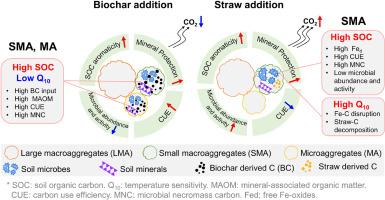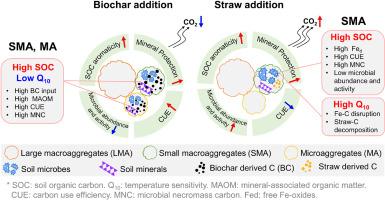团粒大小调节土壤有机碳稳定性和温度敏感性对年代际生物炭和秸秆修正的响应
IF 10.3
1区 农林科学
Q1 SOIL SCIENCE
引用次数: 0
摘要
土壤有机碳(SOC)分解的温度敏感性(Q10)控制着土壤-气候反馈,但土壤管理如何通过总体尺度过程调节Q10尚不清楚。通过14年的田间试验,比较了生物炭和玉米秸秆改性,我们证明了团聚体尺寸对土壤有机碳稳定性和温度响应具有关键的调节作用。生物炭的加入促进了有机碳的固碳(增加49% - 110%),同时抑制了矿化(减少4.9-14%),这主要是通过在小宏观团聚体(SMA)和微团聚体(MA)中优先稳定(即增加苯多羧酸,降低14C年龄和δ13C)。这些小团聚体表现出较高的有机碳稳定性和较低的Q10,因为它们增强了矿物结合,并且提高了微生物碳利用效率(+ 11-39%),增加了微生物坏死块(+ 35-92%)。相比之下,由于fe相关有机碳(高Q10)的热破坏,大宏观团聚体(LMA)的固碳能力有限。玉米秸秆通过物理封闭优先隔离SMA中的有机碳(即,MAOM增加36%,fe -氧化物增加45%),但由于不稳定秸秆c的温度敏感分解,体积Q10增加了89%。相关分析表明,虽然矿物保护降低了所有团聚体的有机碳矿化,但其在Q10中的同步增加突出了变暖脆弱性的权衡。我们的研究结果表明,生物炭在通过集群体特异性稳定途径将有机碳转换与变暖解耦方面优于秸秆,这为优化土壤改良剂以减轻农业系统中的碳-气候反馈提供了重要见解。本文章由计算机程序翻译,如有差异,请以英文原文为准。


Aggregate size mediates the stability and temperature sensitivity of soil organic carbon in response to decadal biochar and straw amendments
The temperature sensitivity (Q10) of soil organic carbon (SOC) decomposition governs soil-climate feedbacks, yet how soil management mediates Q10 through aggregate-scale processes remains unclear. Through a 14-year field experiment comparing biochar and maize straw amendments, we demonstrated that aggregate size critically mediated SOC stability and temperature responses. Biochar addition enhanced SOC sequestration by 49–110 % while suppressing mineralization by 4.9–14 %, primarily through preferential stabilization in small macroaggregates (SMA) and microaggregates (MA) (i.e., increased benzene polycarboxylic acids and decreased 14C age and δ13C). These small aggregates exhibited high SOC stability and low Q10 due to enhanced mineral association, and elevated microbial carbon use efficiency (+11–39 %) for microbial necromass accrual (+35–92 %). By contrast, large macroaggregates (LMA) showed limited SOC sequestration capacity due to thermal disruption of Fe-associated SOC that led to high Q10. Maize straw preferentially sequestered SOC in SMA through physical occlusion (i.e., 36 % increase in MAOM, 45 % increase in Fe-oxides) but increased bulk Q10 by 89 % due to temperature-sensitive decomposition of labile straw-derived C. The correlation analysis indicated that while mineral protection reduced SOC mineralization across all aggregates, its concurrent increase in Q10 highlighted a warming vulnerability tradeoff. Our findings establish that biochar outperforms straw in decoupling SOC turnover from warming through aggregate-specific stabilization pathways, providing critical insights for optimizing soil amendments to mitigate carbon-climate feedbacks in agricultural systems.
求助全文
通过发布文献求助,成功后即可免费获取论文全文。
去求助
来源期刊

Soil Biology & Biochemistry
农林科学-土壤科学
CiteScore
16.90
自引率
9.30%
发文量
312
审稿时长
49 days
期刊介绍:
Soil Biology & Biochemistry publishes original research articles of international significance focusing on biological processes in soil and their applications to soil and environmental quality. Major topics include the ecology and biochemical processes of soil organisms, their effects on the environment, and interactions with plants. The journal also welcomes state-of-the-art reviews and discussions on contemporary research in soil biology and biochemistry.
 求助内容:
求助内容: 应助结果提醒方式:
应助结果提醒方式:


